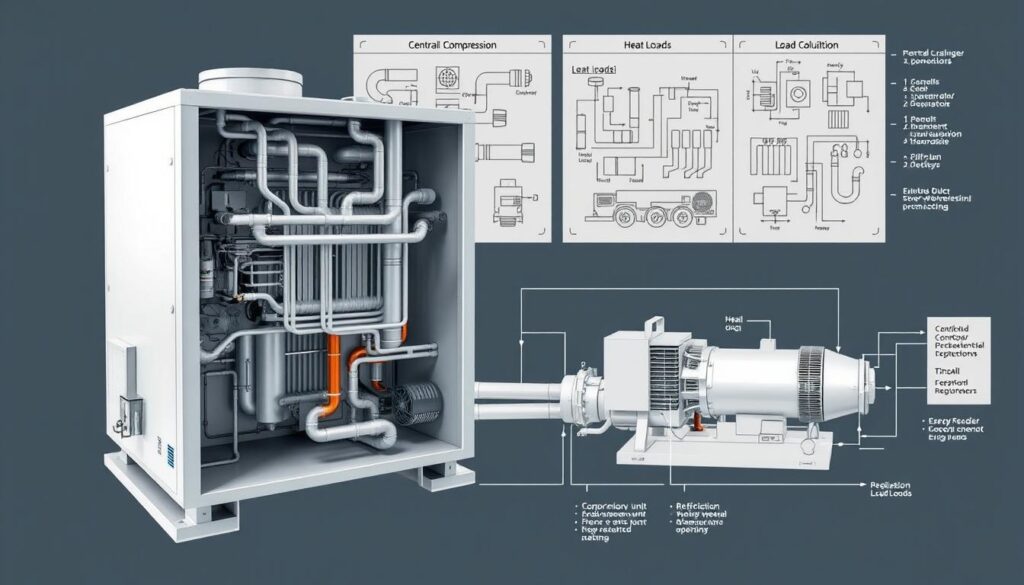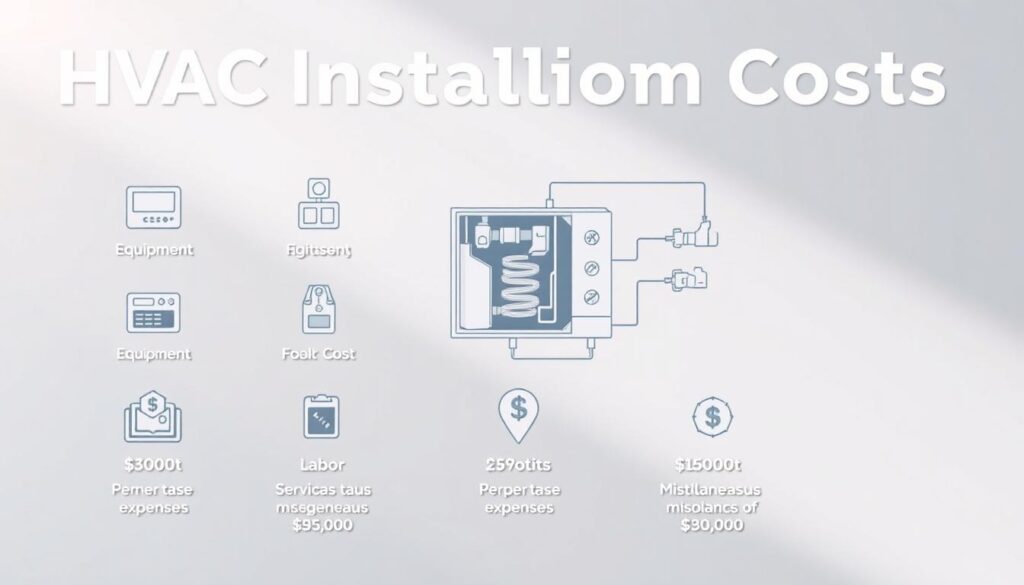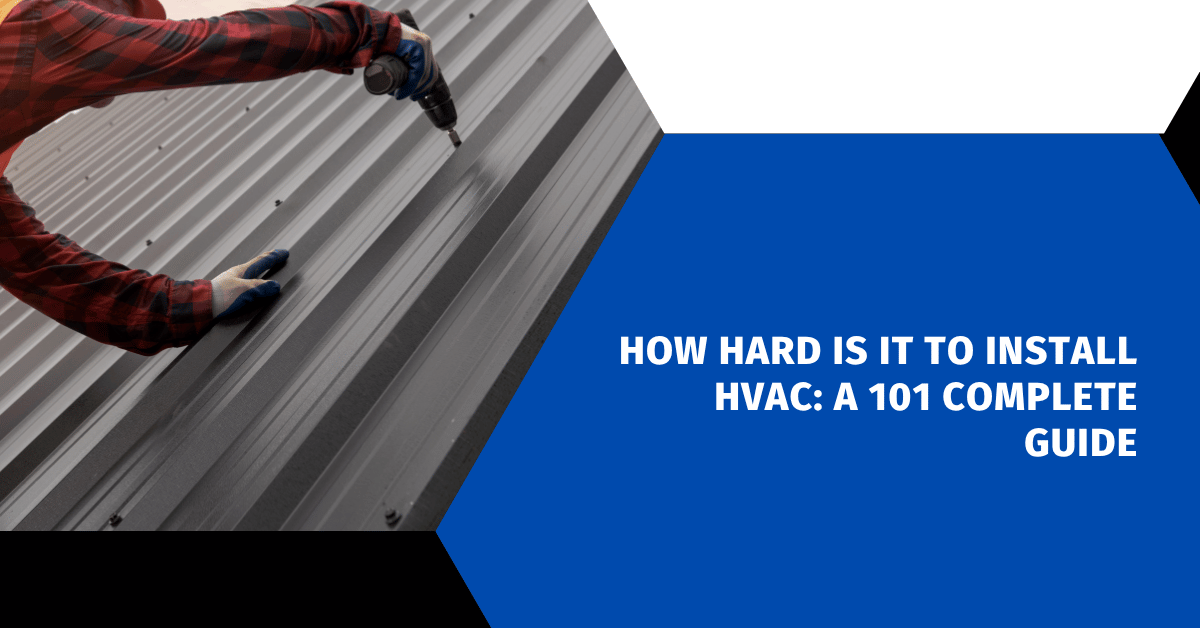Affiliate Disclosure
HVAC Guide Guys is a participant in the Amazon Services LLC Associates Program, an affiliate advertising program designed to provide a means for sites to earn advertising fees by advertising and linking to Amazon.
How Hard Is It to Install HVAC? Are you thinking about installing an HVAC system yourself? Many homeowners are surprised by how complex it is. They think it’s just another home improvement task.

Installing an HVAC system is much more than a simple repair. Technicians spend years learning about heating, ventilation, and air conditioning. Your home’s comfort and energy use depend on it being installed correctly.
While it’s great to want to do things yourself, HVAC installation is not for the weekend. It needs electrical work, precise measurements, and technical skills. Most homeowners don’t have these abilities.
Key Takeaways
- HVAC installation requires professional technical expertise
- Complex system requires specialized knowledge and skills
- Improper installation can lead to significant energy inefficiency
- Professional installation ensures optimal system performance
- Cost of professional installation protects long-term system functionality
Table of Contents
Understanding HVAC System Basics
HVAC systems are the unsung heroes of home comfort. They quietly work to keep your indoor environment perfect. These systems do more than just heat and cool – they also manage air quality and filter out allergens.
When thinking about hvac system installation, knowing the core components is key. A typical system has several important parts that work together:
- Furnace: The heating powerhouse
- Air Conditioner: Cooling mechanism
- Ductwork: Air distribution network
- Thermostat: Temperature control center
How HVAC Systems Function
Your residential hvac installation is like a complex ecosystem. It pulls warm air, cools it, and circulates it throughout your home. In winter, it does the opposite to make your home warm.
“A well-maintained HVAC system can improve energy efficiency by up to 30%”
Types of HVAC Installations
Commercial hvac installation is different from residential systems. Here’s a quick overview of common types:
| System Type | Key Features | Best For |
|---|---|---|
| Split Systems | Indoor and outdoor units | Most residential homes |
| Ductless Mini-Split | No ductwork required | Single rooms, small spaces |
| Packaged Units | All-in-one system | Homes with limited space |
Pro tip: Regular maintenance can extend your HVAC system’s lifespan and ensure optimal performance.
Explore Our HVAC Shop
Looking for top-rated HVAC tools, parts, and accessories? Visit our shop and find the perfect solution for your needs.
Visit the ShopHow Hard Is It to Install HVAC: Expert Assessment
Installing an HVAC system is not a simple task. It needs specialized skills and professional knowledge. Homeowners should not try to do it themselves because it’s too complex.
Professional HVAC technicians face many challenges during installation:
- Intricate electrical connections
- Precise refrigerant handling
- Complex ductwork design
- Compliance with EPA regulations
“HVAC installation is a specialized skill that requires extensive training and certification,” says Mark Rodriguez, HVAC industry expert.
Several factors make installation difficult:
- Specialized technical knowledge
- Understanding complex system components
- Navigating strict building codes
- Ensuring optimal system performance
| Installation Aspect | Difficulty Level | Professional Requirement |
|---|---|---|
| Electrical Connections | High | Certified Technician |
| Refrigerant Handling | Very High | EPA Certified |
| Ductwork Installation | Moderate to High | Experienced Professional |
The EPA mandates specific certifications for technicians handling refrigerants, underscoring the technical expertise required for HVAC installation. DIY installation can be risky. It may lead to safety issues, system inefficiency, and voiding warranties.
Explore Our HVAC Shop
Looking for top-rated HVAC tools, parts, and accessories? Visit our shop and find the perfect solution for your needs.
Visit the ShopEssential Safety Considerations for HVAC Installation
HVAC installation needs careful safety steps. It’s important to keep yourself and your work area safe. Knowing the risks and taking the right safety steps can avoid serious accidents.
For HVAC installation, you need to know a lot about safety. Working with electrical and gas systems is risky. So, it’s key to be well-prepared, whether you’re a pro or a homeowner.
Gas and Electrical Safety Protocols
Gas and electrical parts are dangerous during HVAC setup. To stay safe, follow these rules:
- Always turn off power before starting electrical work
- Lock and tag electrical circuits properly
- Do gas leak tests before and after the job
- Wear the right gear to protect your lungs from gas
Required Protective Equipment
Wearing the right gear is vital for safe HVAC work. Here’s what you should have:
| Safety Item | Purpose |
|---|---|
| Safety Glasses | Protect your eyes from flying debris |
| Steel-Toed Boots | Keep your feet safe when lifting heavy things |
| Thick Work Gloves | Protect your hands from sharp objects |
| Respirator | Keep harmful particles out of your lungs |
Emergency Procedures
Knowing what to do in an emergency is key. Here are some important steps:
- Get out fast if you smell gas
- Have a fire extinguisher ready
- Keep emergency numbers handy
- Stop work and call for help if unsure about something
*Safety isn’t expensive, it’s priceless* – This is true, even more so in HVAC installation where dangers are real.
Following HVAC installation rules helps avoid risks. These safety steps protect both installers and homeowners from accidents during setup.
Sizing and Load Calculations for Your HVAC System

Finding the right size for your HVAC system is key for top performance and saving energy. The Manual J method, backed by the Air Conditioning Contractors of America (ACCA), is a detailed way to figure out your home’s heating and cooling needs.
Several important factors affect the right HVAC system size:
- Home square footage
- Number of windows and doors
- Home insulation quality
- Number of occupants
- Local climate conditions
“Proper HVAC sizing is not just about comfort—it’s about maximizing efficiency and reducing long-term costs.”
Let’s look at a sample calculation for a 2,500 square foot home:
| Factor | BTU Contribution |
|---|---|
| Base Room Size | 62,500 BTUs |
| Occupants (4 people) | 1,600 BTUs |
| Windows (12 total) | 12,000 BTUs |
| Exterior Doors (3) | 3,000 BTUs |
| Total HVAC Load | 79,100 BTUs |
Pro tip: An HVAC system that’s too big or too small can cause big issues. A system that’s too big cycles too often, while one that’s too small runs all the time. Both lead to higher energy bills and a shorter system life.
A well-maintained HVAC system that’s the right size can last 15 to 25 years. This can save you thousands and keep your home comfortable.
Explore Our HVAC Shop
Looking for top-rated HVAC tools, parts, and accessories? Visit our shop and find the perfect solution for your needs.
Visit the ShopEnergy Efficiency Requirements and SEER Ratings
When thinking about hvac installation cost, knowing about energy efficiency is key. Modern HVAC systems are rated by SEER (Seasonal Energy Efficiency Ratio). This rating shows how well a system cools over a season.
The U.S. Department of Energy has set new energy standards. These changes affect hvac installation needs. As of 2023, the main updates are:
- Minimum SEER ratings increased by 8-10%
- Approximately 70% of current HVAC products do not meet new SEER2 guidelines
- Minimum SEER rating set at 14 for northern states
- Minimum SEER rating set at 15 for southern states
Understanding SEER Ratings
SEER ratings measure cooling output versus electrical energy used in a season. Higher SEER ratings mean better energy efficiency.
| SEER Rating | Energy Efficiency Level | Estimated Cost Impact |
|---|---|---|
| 14-15 | Standard Efficiency | Most Cost-Effective |
| 16-20 | High Efficiency | Moderate Additional Cost |
| 21-26 | Premium Efficiency | Significant Investment |
Energy Efficiency Standards
New rules affect hvac installation cost. Split-system air conditioners now need different SEER2 ratings by region:
- Northern regions: Minimum 13.4 SEER2
- Southern regions: Minimum 14.3 SEER2
- Heat pumps: Minimum 14.3 SEER2
Cost-Saving Considerations
“Investing in energy-efficient HVAC systems can lead to substantial long-term savings on utility bills.”
High-efficiency systems might cost more upfront. But, they save a lot on energy bills. Homeowners can save money through:
- Lower monthly energy bills
- Federal tax credits
- Potential utility rebates
- Reduced environmental impact
HVAC Installation Process and Timeline
Understanding the HVAC installation process is key to getting ready for this big home improvement. The time it takes can vary, but knowing what to expect makes it easier.
- Initial home assessment and measurements
- Equipment selection and sizing
- Removal of existing HVAC system
- Ductwork preparation or replacement
- New unit placement
- Electrical and refrigerant line connections
- System testing and calibration
The time needed for HVAC installation can vary a lot. A simple replacement might take just one day. But a full installation could take three to five days. Several things can affect the time needed:
- Home size and layout
- Complexity of ductwork
- Type of HVAC system being installed
- Potential structural modifications
“Proper planning prevents poor performance in HVAC installations.” – HVAC Professional Wisdom
Professional technicians usually need 24 to 40 working hours for a full HVAC system installation. Commercial jobs might take even longer, sometimes weeks, because of their complexity.
Choosing an experienced HVAC contractor can make the installation smoother. It ensures the job is done efficiently and with less disruption to your daily life.
Professional Requirements and Permits
Getting into HVAC installation needs you to know about licenses, rules, and paperwork. It’s important for both homeowners and contractors. It makes sure systems are installed safely and right.
Licensing Requirements for HVAC Professionals
HVAC work needs special skills and a license. In places like California, you must:
- Have at least 4 years of journeyman experience
- Pass tough trade and business exams
- Get specific contractor licenses
Building Codes and Regulations
HVAC rules change by area but follow strict building codes. These codes make sure systems are safe, work well, and meet energy standards.
“Proper permitting and licensing protect both homeowners and contractors from legal issues.”
Necessary Permits and Documentation
Most places need special permits for HVAC work. You’ll need permits for:
- New HVAC systems
- Changing the whole system
- Replacing furnaces or condensers
- Big changes to ductwork
| Permit Type | Cost Range | Processing Time |
|---|---|---|
| Standard HVAC Installation | $50-$300 | 7-14 days |
| Complex System Replacement | $200-$500 | 14-30 days |
Not getting the right permits can lead to big problems. It might stop your project, cause insurance issues, and lower your property’s value. Working with licensed pros makes sure your HVAC is installed correctly.
Explore Our HVAC Shop
Looking for top-rated HVAC tools, parts, and accessories? Visit our shop and find the perfect solution for your needs.
Visit the ShopCost Factors in HVAC Installation

Understanding the cost of HVAC installation can be tricky. Your total cost depends on several important factors. These include the age of your home, the complexity of the system, and your specific needs.
Here are the main cost drivers for HVAC installation:
- Home size and square footage
- Current ductwork condition
- System efficiency ratings
- Local labor rates
- Equipment quality
“The average homeowner can expect to invest between $5,000 and $12,500 for a complete HVAC system replacement.”
The cost of your HVAC installation will change based on the system type. For example, central air conditioning systems cost between $1,900 and $5,500. Geothermal heat pumps can cost from $6,000 to $20,000. Adding ductwork or electrical upgrades can also increase your costs.
Here are some ways to save money:
- Get multiple professional estimates
- Choose high-efficiency systems
- Check available energy rebates
- Maintain existing ductwork if possible
Pro tip: Investing in a high-efficiency system with a superior SEER rating might cost more upfront but can lead to substantial long-term energy savings.
Conclusion
Installing an HVAC system is not a simple weekend task. Your home’s comfort and energy use depend on choosing the right professionals. They must know how to design, size, and install the system correctly.
The cost of a good HVAC system is between $5,000 and $15,000. This shows how important it is to make smart choices. Experts can make your system up to 30% more efficient. They can also cut down on problems by 70% compared to doing it yourself.
Your goal is to make your home comfortable and energy-smart. Hiring licensed professionals ensures your system is the right size and installed well. This leads to better comfort and less energy use over time.
Do your homework to find local HVAC contractors. Check their credentials and talk about your home’s needs. Choosing wisely will make your home more comfortable, save on energy bills, and give you a reliable system for years.

